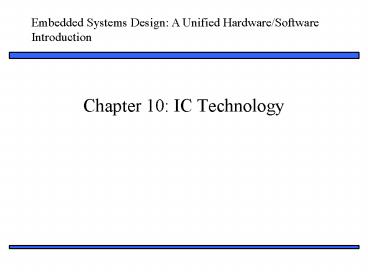Chapter 10: IC Technology - PowerPoint PPT Presentation
1 / 17
Title:
Chapter 10: IC Technology
Description:
Embedded Systems Design: A Unified Hardware/Software Introduction, (c) 2000 Vahid ... NAND. Metal layers for routing (~10) PMOS don't like 0. NMOS don't like 1 ... – PowerPoint PPT presentation
Number of Views:101
Avg rating:3.0/5.0
Title: Chapter 10: IC Technology
1
Chapter 10 IC Technology
2
Outline
- Anatomy of integrated circuits
- Full-Custom (VLSI) IC Technology
- Semi-Custom (ASIC) IC Technology
- Programmable Logic Device (PLD) IC Technology
3
CMOS transistor
- Source, Drain
- Diffusion area where electrons can flow
- Can be connected to metal contacts (vias)
- Gate
- Polysilicon area where control voltage is applied
- Oxide
- Si O2 Insulator so the gate voltage cant leak
4
End of the Moores Law?
- Every dimension of the MOSFET has to scale
- (PMOS) Gate oxide has to scale down to
- Increase gate capacitance
- Reduce leakage current from S to D
- Pinch off current from source to drain
- Current gate oxide thickness is about 2.5-3nm
- Thats about 25 atoms!!!
5
(No Transcript)
6
20Ghz
- FinFET has been manufactured to 18nm
- Still acts as a very good transistor
- Simulation shown that it can be scaled to 10nm
- Quantum effect start to kick in
- Reduce mobility by 10
- Ballistic transport become significant
- Increase current by about 20
7
NAND
- Metal layers for routing (10)
- PMOS dont like 0
- NMOS dont like 1
- A stick diagram form the basis for mask sets
8
Silicon manufacturing steps
- Tape out
- Send design to manufacturing
- Spin
- One time through the manufacturing process
- Photolithography
- Drawing patterns by using photoresist to form
barriers for deposition
9
Full Custom
- Very Large Scale Integration (VLSI)
- Placement
- Place and orient transistors
- Routing
- Connect transistors
- Sizing
- Make fat, fast wires or thin, slow wires
- May also need to size buffer
- Design Rules
- simple rules for correct circuit function
- Metal/metal spacing, min poly width
10
Full Custom
- Best size, power, performance
- Hand design
- Horrible time-to-market/flexibility/NRE cost
- Reserve for the most important units in a
processor - ALU, Instruction fetch
- Physical design tools
- Less optimal, but faster
11
Semi-Custom
- Gate Array
- Array of prefabricated gates
- place and route
- Higher density, faster time-to-market
- Does not integrate as well with full-custom
- Standard Cell
- A library of pre-designed cell
- Place and route
- Lower density, higher complexity
- Integrate great with full-custom
12
Semi-Custom
- Most popular design style
- Jack of all trade
- Good
- Power, time-to-market, performance, NRE cost,
per-unit cost, area - Master of none
- Integrate with full custom for critical regions
of design
13
(No Transcript)
14
Programmable Logic Device
- Programmable Logic Device
- Programmable Logic Array, Programmable Array
Logic, Field Programmable Gate Array - All layers already exist
- Designers can purchase an IC
- To implement desired functionality
- Connections on the IC are either created or
destroyed to implement - Benefits
- Very low NRE costs
- Great time to market
- Drawback
- High unit cost, bad for large volume
- Power
- Except special PLA
- slower
1600 usable gate, 7.5 ns 7 list price
15
Xilinx FPGA
16
Configurable Logic Block (CLB)
17
I/O Block

